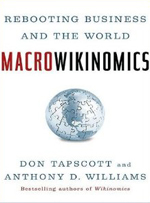This article is the fourth installment in series to be written by Don Tapscott and Anthony D. Williams, authors of the newly released book Macrowikinomics: Rebooting Business and the World. Mark Parker, the CEO of Nike calls it "A masterpiece. An iconic and defining book for our times." The Economist says it's a Schumpeterian story of creative Destruction."
The book argues that many of the institutions of the industrial age have finally come to the end of their lifecycle, and are now being reinvented around a new set of principles and a networked model.
Today's blog, at the Beginning of American Education Week is about how to fix the schools.
****
The film Waiting for "Superman" has sparked heated discussion about the failures of the U.S. public school system, and more broadly with public education everywhere. The movie argues that teachers are at the center of the problem and that the solution is charter schools.
But it's wrong to blame teachers, who overall are a) underpaid, and b) striving to do the best with the limited resources they are given. Nor does the research show that charter schools achieve better outcomes.
The root of the malaise in our schools is the outmoded model of pedagogy. Teachers and text books are assumed to be the source of knowledge. Teachers "teach" -- they impart knowledge to their students, who through practice and assignments learn how to perform well on tests.
This is the very best model of pedagogy that 18th century technology can provide. It's teacher-centered model that is one way, one-size-fits-all and the student is isolated in the learning process. It's time for a rethinking of the entire model of learning. We need to move to a customized and collaborative model that embraces 21st century learning technology and techniques. This is not about technology per se -- it's about a change in the relationship between the student and teacher in the learning process.
By now, virtually every schoolchild in the U.S. and Canada knows how to use the Internet to have fun, talk to friends, play games and explore. But when they get into the typical classroom, most of them step back in time, to a world that would be familiar to teachers 200 years ago when blackboard and chalk were introduced as a brilliant new way to visualize information.
But what would happen if the classroom were brought into the 21st century? One doesn't have to guess: there are some extraordinary initiatives that come from some surprising places, outside the US. The province of New Brunswick in Canada did it five years ago when it handed out laptops to Grade 7 and 8 students and teachers in six schools, French and English.
The results from the first two years of the pilot project "have been dramatic and overwhelmingly positive for all involved with the project," according to two prominent academics who reviewed the two-year project. The report card, by Michael Fox, vice-president of Mount Allison University, and Jim Greenlaw, dean of education at University of Ontario Institute of Technology, was glowing: Students wrote more, and produced higher quality work. They demonstrated effective research, analytical and evaluative skills in the digital environment. They were more interested in learning. School was more fun. Their grades went up. The results were so positive that New Brunswick expanded the one-laptop-per-child program to cover 3900 school children, or 23 per cent of Grade 7 and 8 students, over five years, ending in June.
Yet still today, most public school classrooms remain stuck in the trapping of the 18th century, not in the 21st century in which we live. Many policy makers blame the perceived cost, which could be as much as $1,000 per year if you include teacher training, maintenance, and all the other costs of ownership. (The New Brunswick program cost $37.2 million over five years.) Yet the real issue, as Fox and Greenlaw suggest, is our vision: Are we, the adults, willing to accept that children who are growing up digital learn far more in an interactive, collaborative environment? And just as important, are we willing to allocate the resources needed to modernize an Industrial Age form of education that isn't much good for children who have to work in a digital age? Indeed, if we can find hundreds of billions to bailout Wall Street, why can't we find a fraction of that amount to put essential 21st century tools in the hands of every student?
To break from the past takes courage and vision, and yes it will take financial resources too. If policy makers are hunting for a new economic model for education, they might take a look at Portugal, a modest country across the Atlantic that's turning into the world leader in rethinking education for the 21st century. In early 2005 Portugal's economy was sagging, and it was running out of the usual economic fixes. It also scored some of the lowest educational achievement results in Western Europe.
So Prime Minister Jose Socrates took a courageous step. He decided to invest heavily in a "technological shock" to jolt his country into the 21st century. This meant, among other things, that he'd make sure everyone in the workforce could handle a computer and use the Internet effectively. This would transform Portuguese society by giving people immediate access to the online world. It would open up huge opportunities that could make Portugal a richer and more competitive country.
In 2005, only 31% of the Portuguese households had access to the Internet. To improve this penetration, the logical place to start was in school, where there was only one computer for five kids. The aim was to have one computer for every two students by 2010.
So Portugal launched the biggest program in the world to equip every child in the country with a laptop and access to the web and the world of collaborative learning. To pay for it, Portugal tapped into both government funds and money from mobile operators who were granted 3G licenses. That subsidized the sale of one million ultra-cheap laptops to teachers, school children, and adult learners.
Here's how it works: If you're a teacher or a student, you can buy a laptop for 150 euros (U.S. $207). You also get a discounted rate for broadband Internet access, wired or wireless. Low income students get an even bigger discount, and connected laptops are free or virtually free for the poorest kids. For the youngest students in Grades 1 to 4, the laptop/Internet access deal is even cheaper -- 50 euros for those who can pay; free for those who can't.
That's only the start: Portugal has invested 400 million euros to makes sure each classroom has access to the Internet. Just about every classroom in the public system now has an interactive smart board, instead of the old fashioned blackboard.
This means that nearly nine out of 10 students in Grades 1 to 4 have a laptop on their desk. The impact on the classroom is tremendous, as we saw this spring while touring a classroom of seven-year-olds in a public school in Lisbon. It was the most exciting, noisy, collaborative classroom we have seen in the world.
The teacher directed the kids to an astronomy blog with a beautiful color image of a rotating solar system on the screen. "Now," said the teacher, "Who knows what the equinox is?"
Nobody knew.
"Alright, why don't you find out?"
The chattering began, as the children clustered together to figure out what an equinox was. Then one group leapt up and waved their hands. They found it! They then proceeded to explain the idea to their classmates.
This was the exact opposite of everything that is wrong with the classroom system in North America.
The children in this Portuguese classroom loved learning about astronomy. They were collaborating. They were working at their own pace. They barely noticed the technology; it was like air to them. But it changed the relationship they had with their teacher. Instead of fidgeting in their chairs while the teacher lectures and scrawls some notes on the blackboard, they were the explorers, the discoverers, and the teacher was their helpful guide.
Yet too often in the American school system, teachers still rely on the traditional model of education. Teachers often feel that this is the only way to teach a large classroom of kids, and yet the classroom in Portugal shows that giving kids laptops can free the teacher to introduce a new way of learning that's more natural for kids who have grown up digital at home.
First, it allows teachers to step off the stage and start listening and conversing instead of just lecturing. Second, the teacher can encourage students to discover for themselves, and learn a process of discovery and critical thinking instead of just memorizing the teacher's information. Third, the teacher can encourage students to collaborate among themselves and with others outside the school. Finally, the teacher can tailor the style of education to their students' individual learning styles.
Portugal has been careful to invest in teacher training to capitalize on the possibilities of the laptops. It's also thinking of creating a new online platform to allow teachers to work together to create new lessons and course materials that take advantage of the interactive technology. Through this collaboration, the Portuguese school system will create exciting new online materials to educate children. Lots of ideas are already making their way into Portuguese classrooms, says Mario Franco, chair of the Foundation for Mobile Communication, which is managing the e-school program. There are 50 different educational programs and games inside the laptops the youngest children use. The laptops are even equipped with a control to encourage kids to finish their homework and score high marks. If they do, they get more time to play.
It's too early to assess the impact on learning in Portuguese schools. Studies of the impact of computers in schools elsewhere have been inconclusive, or mixed. One key problem is that simply providing computers in schools is not enough. Teachers facing a classroom of kids with laptops need to learn that they are no longer the expert in their domain; the Internet is.
It's heartening to know that a tiny province like New Brunswick is giving teachers plenty of opportunity to change their mode of teaching. Teachers can tap into government funds to create new and innovative programs. They can work with teachers around the globe to come up with new ways of teaching that make the most of the technological tools. Teens in New Brunswick are encouraged to meet teens around the globe in online forums and collaborate with them on projects. Technology, in other words, is only the tool. The real work is creating a new model of learning -- one that fits the 21st century.
Macrowikinomics available at: Macrowikinomics.com
Follow Anthony Williams on Twitter: www.twitter.com/adw_tweets

